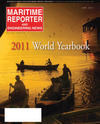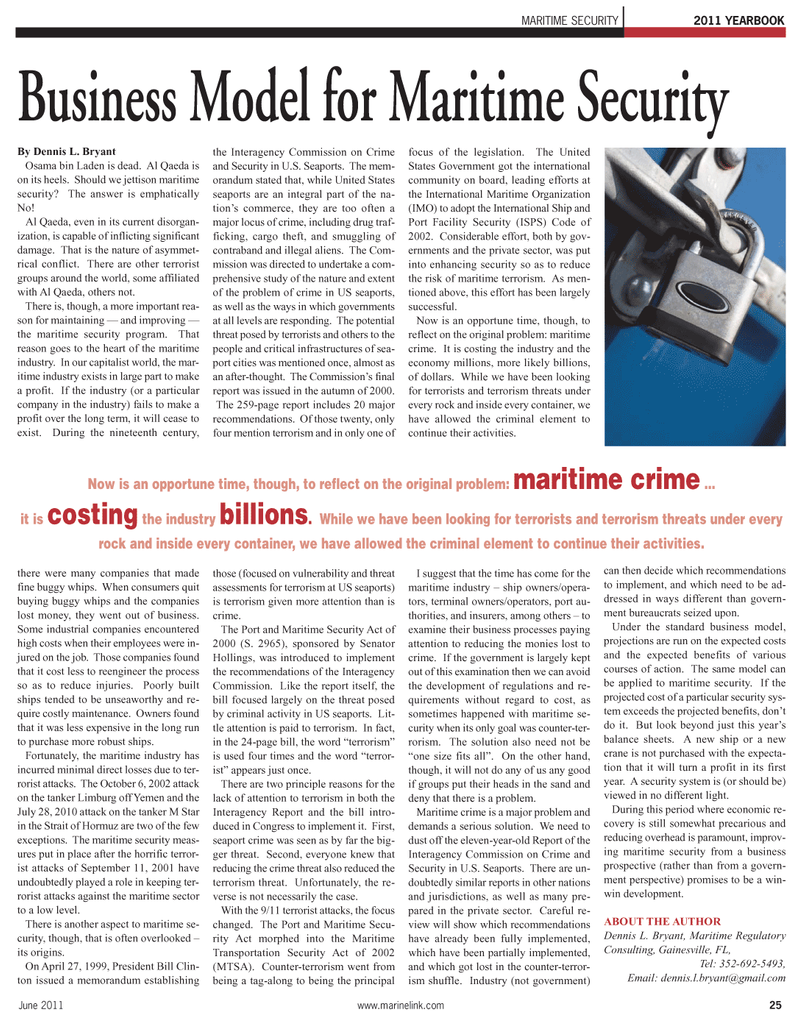
Page 29: of Maritime Reporter Magazine (June 2011)
Feature: Annual World Yearbook
Read this page in Pdf, Flash or Html5 edition of June 2011 Maritime Reporter Magazine
By Dennis L. BryantOsama bin Laden is dead. Al Qaeda is on its heels. Should we jettison maritime security? The answer is emphatically No!Al Qaeda, even in its current disorgan- ization, is capable of inflicting significant damage. That is the nature of asymmet- rical conflict. There are other terrorist groups around the world, some affiliated with Al Qaeda, others not. There is, though, a more important rea-son for maintaining ? and improving ? the maritime security program. That reason goes to the heart of the maritimeindustry. In our capitalist world, the mar- itime industry exists in large part to make a profit. If the industry (or a particular company in the industry) fails to make a profit over the long term, it will cease to exist. During the nineteenth century, there were many companies that made fine buggy whips. When consumers quit buying buggy whips and the companies lost money, they went out of business. Some industrial companies encounteredhigh costs when their employees were in- jured on the job. Those companies found that it cost less to reengineer the processso as to reduce injuries. Poorly built ships tended to be unseaworthy and re- quire costly maintenance. Owners found that it was less expensive in the long run to purchase more robust ships. Fortunately, the maritime industry has incurred minimal direct losses due to ter- rorist attacks. The October 6, 2002 attack on the tanker Limburg off Yemen and the July 28, 2010 attack on the tanker M Star in the Strait of Hormuz are two of the few exceptions. The maritime security meas- ures put in place after the horrific terror- ist attacks of September 11, 2001 have undoubtedly played a role in keeping ter- rorist attacks against the maritime sectorto a low level. There is another aspect to maritime se-curity, though, that is often overlooked ? its origins.On April 27, 1999, President Bill Clin- ton issued a memorandum establishingthe Interagency Commission on Crime and Security in U.S. Seaports. The mem- orandum stated that, while United Statesseaports are an integral part of the na- tions commerce, they are too often a major locus of crime, including drug traf-ficking, cargo theft, and smuggling of contraband and illegal aliens. The Com- mission was directed to undertake a com- prehensive study of the nature and extent of the problem of crime in US seaports,as well as the ways in which governments at all levels are responding. The potential threat posed by terrorists and others to thepeople and critical infrastructures of sea-port cities was mentioned once, almost as an after-thought. The Commissions final report was issued in the autumn of 2000. The 259-page report includes 20 majorrecommendations. Of those twenty, only four mention terrorism and in only one ofthose (focused on vulnerability and threatassessments for terrorism at US seaports)is terrorism given more attention than is crime.The Port and Maritime Security Act of 2000 (S. 2965), sponsored by SenatorHollings, was introduced to implement the recommendations of the Interagency Commission. Like the report itself, the bill focused largely on the threat posed by criminal activity in US seaports. Lit- tle attention is paid to terrorism. In fact, in the 24-page bill, the word terrorism? is used four times and the word terror- ist? appears just once.There are two principle reasons for the lack of attention to terrorism in both theInteragency Report and the bill intro- duced in Congress to implement it. First, seaport crime was seen as by far the big- ger threat. Second, everyone knew that reducing the crime threat also reduced theterrorism threat. Unfortunately, the re- verse is not necessarily the case. With the 9/11 terrorist attacks, the focus changed. The Port and Maritime Secu- rity Act morphed into the Maritime Transportation Security Act of 2002 (MTSA). Counter-terrorism went from being a tag-along to being the principalfocus of the legislation. The United States Government got the international community on board, leading efforts at the International Maritime Organization (IMO) to adopt the International Ship andPort Facility Security (ISPS) Code of 2002. Considerable effort, both by gov- ernments and the private sector, was put into enhancing security so as to reducethe risk of maritime terrorism. As men- tioned above, this effort has been largely successful.Now is an opportune time, though, to reflect on the original problem: maritimecrime. It is costing the industry and the economy millions, more likely billions, of dollars. While we have been looking for terrorists and terrorism threats underevery rock and inside every container, we have allowed the criminal element to continue their activities. I suggest that the time has come for themaritime industry ? ship owners/opera- tors, terminal owners/operators, port au- thorities, and insurers, among others ? toexamine their business processes paying attention to reducing the monies lost tocrime. If the government is largely kept out of this examination then we can avoid the development of regulations and re- quirements without regard to cost, as sometimes happened with maritime se-curity when its only goal was counter-ter- rorism. The solution also need not be one size fits all?. On the other hand, though, it will not do any of us any good if groups put their heads in the sand anddeny that there is a problem. Maritime crime is a major problem anddemands a serious solution. We need to dust off the eleven-year-old Report of the Interagency Commission on Crime and Security in U.S. Seaports. There are un- doubtedly similar reports in other nationsand jurisdictions, as well as many pre- pared in the private sector. Careful re- view will show which recommendations have already been fully implemented, which have been partially implemented, and which got lost in the counter-terror- ism shuffle. Industry (not government) can then decide which recommendationsto implement, and which need to be ad-dressed in ways different than govern- ment bureaucrats seized upon. Under the standard business model, projections are run on the expected costs and the expected benefits of various courses of action. The same model can be applied to maritime security. If the projected cost of a particular security sys-tem exceeds the projected benefits, dont do it. But look beyond just this years balance sheets. A new ship or a new crane is not purchased with the expecta- tion that it will turn a profit in its first year. A security system is (or should be) viewed in no different light. During this period where economic re-covery is still somewhat precarious and reducing overhead is paramount, improv- ing maritime security from a business prospective (rather than from a govern- ment perspective) promises to be a win- win development. ABOUT THE AUTHOR Dennis L. Bryant, Maritime Regulatory Consulting, Gainesville, FL, Tel: 352-692-5493, Email: [email protected] 2011www.marinelink.com 25MARITIME SECURITY2011 YEARBOOKNow is an opportune time, though, to reflect on the original problem: maritime crime... it is costingthe industry billions. While we have been looking for terrorists and terrorism threats under every rock and inside every container, we have allowed the criminal element to continue their activities. Business Model for Maritime Security

 28
28

 30
30
